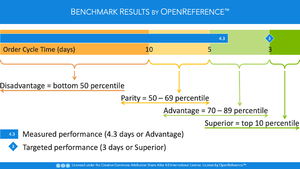Actions
Note: Common inputs and outputs are listed in alphabetical order. Other inputs and outputs may be required to support varying use cases.Benchmark Supply Chain Align Strategy 4111100 3 {{{keywords}}} {{{description}}}
A111
Difference between revisions of "A111"
m (1 revision imported: 2017 Reset) |
|||
| (One intermediate revision by the same user not shown) | |||
| Line 1: | Line 1: | ||
The activities associated with collecting data, submitting/calculating data and analysis of benchmark information for key metrics for each supply chain. Supply chain benchmarking is performed for high-level metrics (level-1, some level-2 metrics) as part of strategy management only: Strategy is set by means of high-level metrics only (For example: Order Fulfillment Cycle-time, not 'the time it takes to enter an order'). | The activities associated with collecting data, submitting/calculating data and analysis of benchmark information for key metrics for each supply chain. Supply chain benchmarking is performed for high-level metrics (level-1, some level-2 metrics) as part of strategy management only: Strategy is set by means of high-level metrics only (For example: Order Fulfillment Cycle-time, not 'the time it takes to enter an order'). | ||
| − | Benchmarking involves reviewing [[Link::t:KPI|Key Performance Indicators (KPIs)]] for a supply chain against internal supply chains (peer benchmarking), or external competitive data (competitive benchmarking), with a goal of understanding potential [[Link::t:KPI]] targets, and gaps in performance. | + | [[File:OR-BMR.png|thumb|Benchmark Results explanation]]Benchmarking involves reviewing [[Link::t:KPI|Key Performance Indicators (KPIs)]] for a supply chain against internal supply chains (peer benchmarking), or external competitive data (competitive benchmarking), with a goal of understanding potential [[Link::t:KPI]] targets, and gaps in performance. |
Without Supply Chain Segmentation, benchmarking is performed on aggregate data potentially providing misleading results. Benchmarking with external data without understanding internal performance may create credibility gaps. [[Category:Process]][[Category:Supply Chain]] | Without Supply Chain Segmentation, benchmarking is performed on aggregate data potentially providing misleading results. Benchmarking with external data without understanding internal performance may create credibility gaps. [[Category:Process]][[Category:Supply Chain]] | ||
| Line 7: | Line 7: | ||
|name=Benchmark Supply Chain | |name=Benchmark Supply Chain | ||
|parent=sc:A1 | |parent=sc:A1 | ||
| − | |sort= | + | |sort=4111100 |
|level=3 | |level=3 | ||
}} | }} | ||
Latest revision as of 14:59, 27 October 2021
The activities associated with collecting data, submitting/calculating data and analysis of benchmark information for key metrics for each supply chain. Supply chain benchmarking is performed for high-level metrics (level-1, some level-2 metrics) as part of strategy management only: Strategy is set by means of high-level metrics only (For example: Order Fulfillment Cycle-time, not 'the time it takes to enter an order').
Benchmarking involves reviewing Key Performance Indicators (KPIs) for a supply chain against internal supply chains (peer benchmarking), or external competitive data (competitive benchmarking), with a goal of understanding potential Discuss Contract Custom Solution targets, and gaps in performance.Without Supply Chain Segmentation, benchmarking is performed on aggregate data potentially providing misleading results. Benchmarking with external data without understanding internal performance may create credibility gaps.
Workflow
| Process |
| ||||||||||||
|---|---|---|---|---|---|---|---|---|---|---|---|---|---|---|
|
A111 |
|
||||||||||||
